IdentityServer4授权和认证对接数据库
Posted nsky
tags:
篇首语:本文由小常识网(cha138.com)小编为大家整理,主要介绍了IdentityServer4授权和认证对接数据库相关的知识,希望对你有一定的参考价值。
接着上一篇讲:https://www.cnblogs.com/nsky/p/10352678.html
我们之前都是用in-men的方式把数据添加到内存了,目的是为了测试方便,
现在我们把所有配置都添加到数据库中
用IdeneityServer4 + EntityFramework + ASP.NET Identity的方式
上篇已经讲过identity和profile的对接,这里讲讲配置信息
之前都是这样做的

添加包:IdentityServer4.EntityFramework
里面有专门的2个DbContext管理对应的信息
分别是:PersistedGrantDbContext 和 ConfigurationDbContext
如果还记得Identity,里面有个ApplicationDbContext
所以这里总共有3个DbContext
ApplicationDbContext
PersistedGrantDbContext
ConfigurationDbContext
ApplicationDbContext - 负责涉及ASP.NET Identity的用户所以表
dbo.AspNetRoleClaims
dbo.AspNetRoles
dbo.AspNetUserClaims
dbo.AspNetUserLogins
dbo.AspNetUserRoles
dbo.AspNetUsers
dbo.AspNetUserTokens
PersistedGrantDbContext - 负责存储同意,授权代码,刷新令牌和引用令牌
dbo.PersistedGrants
ConfigurationDbContext - 负责数据库中剩余的所有其他内容
所以关于迁移,如果我更新任何AspNet Identity模型(即ApplicationUser),那么我将在ApplicationDbContext上运行迁移。任何客户端表或其他范围都将在ConfigurationDbContext上运行。并且访问entites(或表)将是相应的上下文。
添加包之后,添加依赖注入配置
.AddConfigurationStore(options => { options.ConfigureDbContext = builder => { builder.UseSqlServer(Configuration.GetConnectionString("conn"), sql => sql.MigrationsAssembly(migrationAssembly)); }; }) /* 这里存储的是,给用户授权的token和一些授权信息 添加来自数据库的操作数据(codes, tokens, consents) */ .AddOperationalStore(options => { options.ConfigureDbContext = builder => { builder.UseSqlServer(Configuration.GetConnectionString("conn"), sql => sql.MigrationsAssembly(migrationAssembly)); }; })
migrationAssembly是当前程序集;
var migrationAssembly = typeof(Startup).GetTypeInfo().Assembly.GetName().Name;
接下来生成migration,在项目的程序包管理控制台输入:
Add-Migration InitConfiguration -Context ConfigurationDbContext -o DateMigrationsIdentityServerConfiguragtionDb
Add-Migration InitConfiguration -Context PersistedGrantDbContext -o DateMigrationsIdentityServerPersistedGrantDb
这样就添加了两个migration
执行update-database生成表
update-database -context ConfigurationDbContext
Update-Database -Context PersistedGrantDbContext
这样就生成了表

因为现在还没有界面录入,可以先手动初始化配置文件 到数据库,因为之前有config.cs
可以直接映射到model写入数据库
/// <summary> /// 因为现在没有通过UI去录入api,client等信息 /// 所有可以先init一些默认信息写入数据库 /// </summary> /// <param name="app"></param> public void InitIdentityServerDataBase(IApplicationBuilder app) { //ApplicationServices返回的就是IServiceProvider,依赖注入的容器 using (var scope = app.ApplicationServices.CreateScope()) { //Update-Database scope.ServiceProvider.GetService<PersistedGrantDbContext>().Database.Migrate(); //var provide = scope.ServiceProvider.GetService<PersistedGrantDbContext>(); //ckk.PersistedGrants.Add(new IdentityServer4.EntityFramework.Entities.PersistedGrant { //}); var configurationDbContext = scope.ServiceProvider.GetRequiredService<ConfigurationDbContext>(); /* 如果不走这个, 那么应该手动执行 Update-Database -Context PersistedGrantDbContext */ configurationDbContext.Database.Migrate(); if (!configurationDbContext.Clients.Any()) { foreach (var client in Config.GetClients()) { //client.ToEntity() 会把当前实体映射到EF实体 configurationDbContext.Clients.Add(client.ToEntity()); } configurationDbContext.SaveChanges(); } if (!configurationDbContext.ApiResources.Any()) { foreach (var api in Config.GetApiResources()) { configurationDbContext.ApiResources.Add(api.ToEntity()); } configurationDbContext.SaveChanges(); } if (!configurationDbContext.IdentityResources.Any()) { foreach (var identity in Config.GetIdentityResource()) { configurationDbContext.IdentityResources.Add(identity.ToEntity()); } configurationDbContext.SaveChanges(); } } }
在Configure中调用
InitIdentityServerDataBase(app);
dotnet run就有数据了
客户端不用配置,
获取refresh_token,混合模式是支持refresh_token的
详情:https://www.cnblogs.com/jesse2013/p/oidc-in-aspnetcore-with-identity-server.html
IdentityResource新增offline_access身份
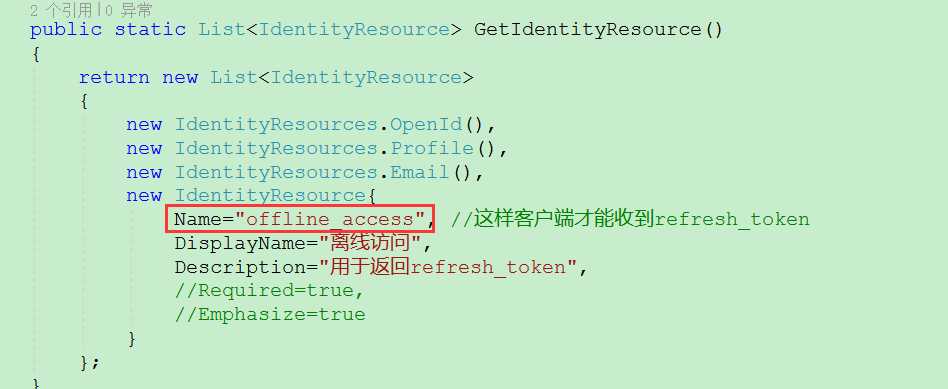
AllowedScopes可以不用加: IdentityServerConstants.StandardScopes.OfflineAccess
服务端Client设置允许: AllowOfflineAccess = true,
客户端配置:options.Scope.Add("offline_access");

拿到这个refresh_token,可以刷新access_token

一个refresh_token只能用一次,否则:

通过这个access_token就看访问资源api了
但就算授权了。也只能访问授权的api
identityResurce是资源信息,AllowedScopes设置了
IdentityServerConstants.StandardScopes.OpenId,
IdentityServerConstants.StandardScopes.Email,
IdentityServerConstants.StandardScopes.Profile,
就会返回这些信息,
OpenId是必须要的,因为OIDC要通过openid确认身份
Profile是可选的,只是客户端默认是传了Profile的,
因为oidc就是为了返回用信息而来的
Profile包含了一些基本的信息
name
family_name
given_name
middle_name
nickname
preferred_username
profile
picture
website
gender
birthdate
zoneinfo
locale
updated_at
Email包含了email 和 email_verified
这些从源码可以看到:
https://github.com/IdentityServer/IdentityServer4/blob/63a50d7838af25896fbf836ea4e4f37b5e179cd8/src/Constants.cs
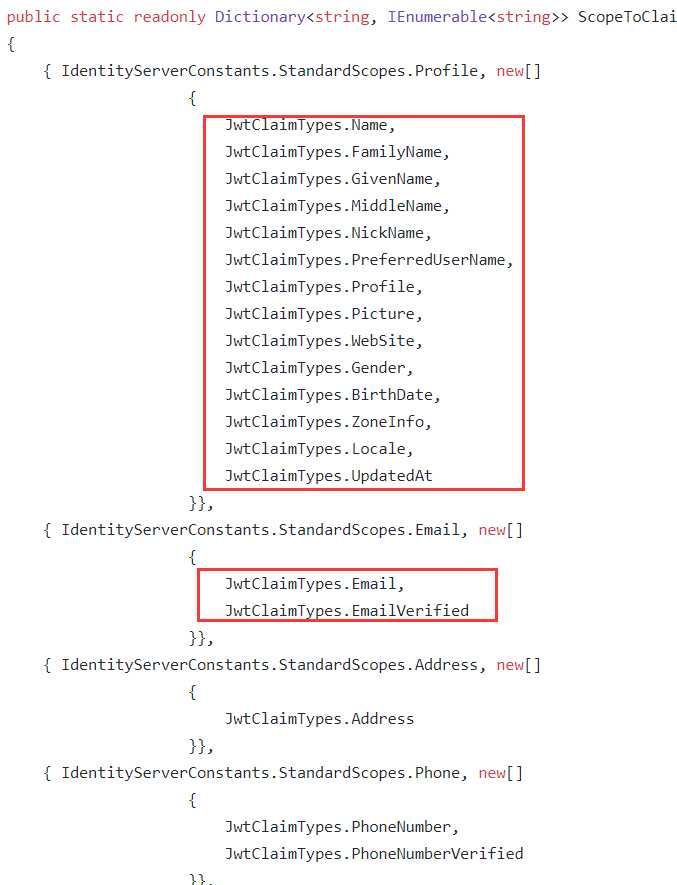
所以客户端获取的cliams是这些
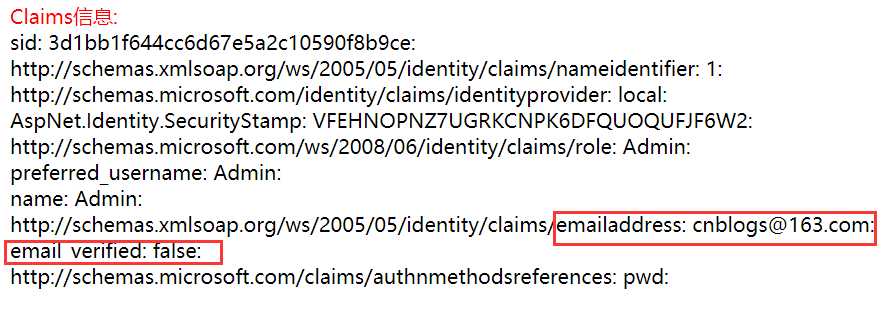
因为profile是在我们的ProfileServices类返回的
那么如果用户没有选择
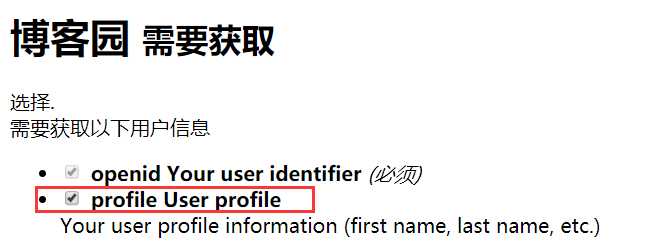
是不是应该不返回profile信息呢?
GetProfileDataAsync方法的context可以拿到当前请求的IdentityResources和ApiResource

好像通过 var claimTypes = context.RequestedClaimTypes;也可以判断,选择了profile,那么RequestedClaimTypes是有值的
当然除了了一些基本信息外,客户端还想获取其他资源,这也是可以的
比如资源服务器有个接口,获取额外的新,scope叫:OtherInfo

客户端请求scope:options.Scope.Add("OtherInfo");
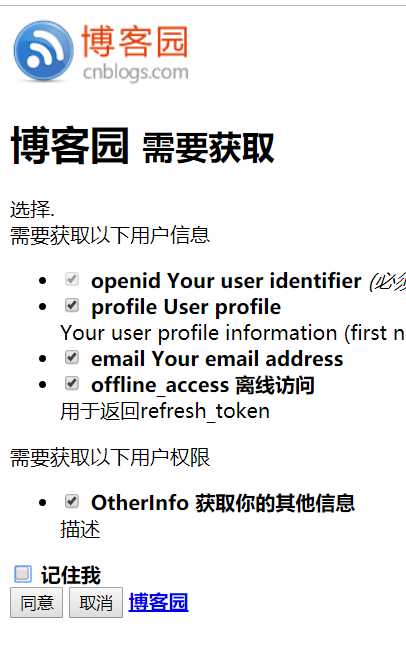
可以看到上面是身份信息,就是会返回的的用户信息
下面是权限,就是可以去资源服务器获取的那些权限,因为:access toke管的是权限
1:先不选择,拿到是access_token里面的scope是没有OtherInfo的
这里为啥有两个offline_access?我也不知道
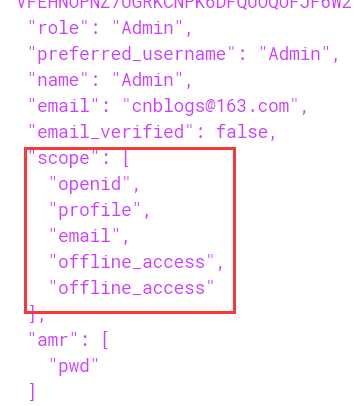
2:如果选择的话。如果不出错的话是有的
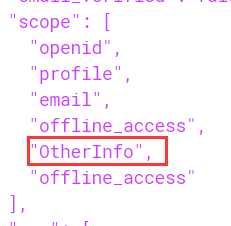
那么资源服务器就可以根据当前这个scope来判断了
[HttpGet] public ActionResult GetOtherInfo() { //判断是否授权 var scope = User.Claims.FirstOrDefault(f => f.Type == "scope" && f.Value == "OtherInfo"); if (scope != null) { return new JsonResult( new { phone = "110", address = "china", age = "20", gender = "m", hobby = "coding" } ); } else //禁止访问 { return BadRequest(StatusCodes.Status403Forbidden); } }
如果授权请求了OtherInfo请求是成功了

当没有授权OtherInfo的时候,当然,返回什么信息你可以自己定义

这说明你只有权限访问资源服务器,授权了的api。
如果你的access_token是错误的。就说明你没有授权,你都没有机会进入api,会提示401

或者写一个过滤器,弄个接口规范,获取某些参数进行判断
目前我想到的方法就是这样,也许不是最好的
既然access_token包含profile信息,它又是JWT类型,那是不是可以DeCode呢?
答案是可以的:

界面输出

源码:https://github.com/byniqing/OAuth2Authorization
参考:https://cloud.tencent.com/developer/article/1048128
以上是关于IdentityServer4授权和认证对接数据库的主要内容,如果未能解决你的问题,请参考以下文章
